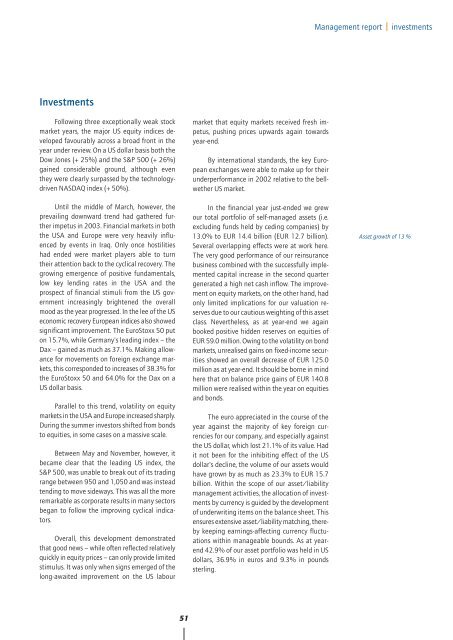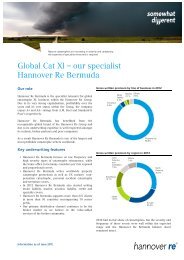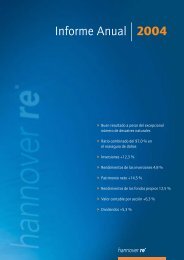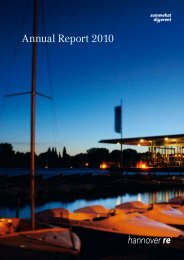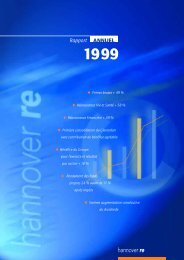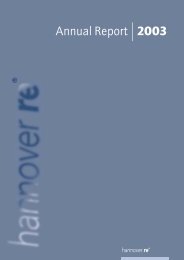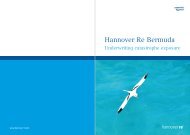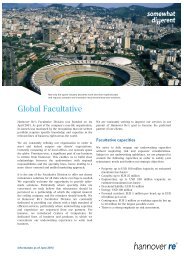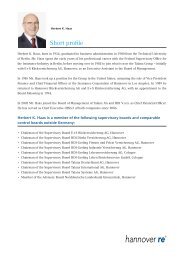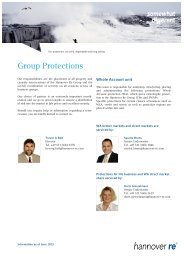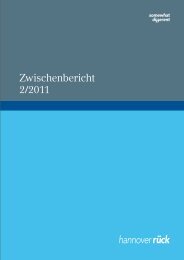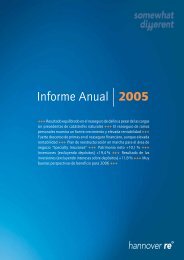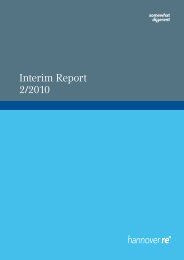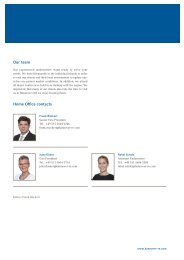Annual Report 2003 - Hannover Re
Annual Report 2003 - Hannover Re
Annual Report 2003 - Hannover Re
You also want an ePaper? Increase the reach of your titles
YUMPU automatically turns print PDFs into web optimized ePapers that Google loves.
Management report<br />
investments<br />
Investments<br />
Following three exceptionally weak stock<br />
market years, the major US equity indices developed<br />
favourably across a broad front in the<br />
year under review. On a US dollar basis both the<br />
Dow Jones (+ 25%) and the S&P 500 (+ 26%)<br />
gained considerable ground, although even<br />
they were clearly surpassed by the technologydriven<br />
NASDAQ index (+ 50%).<br />
Until the middle of March, however, the<br />
prevailing downward trend had gathered further<br />
impetus in <strong>2003</strong>. Financial markets in both<br />
the USA and Europe were very heavily influenced<br />
by events in Iraq. Only once hostilities<br />
had ended were market players able to turn<br />
their attention back to the cyclical recovery. The<br />
growing emergence of positive fundamentals,<br />
low key lending rates in the USA and the<br />
prospect of financial stimuli from the US government<br />
increasingly brightened the overall<br />
mood as the year progressed. In the lee of the US<br />
economic recovery European indices also showed<br />
significant improvement. The EuroStoxx 50 put<br />
on 15.7%, while Germany's leading index – the<br />
Dax – gained as much as 37.1%. Making allowance<br />
for movements on foreign exchange markets,<br />
this corresponded to increases of 38.3% for<br />
the EuroStoxx 50 and 64.0% for the Dax on a<br />
US dollar basis.<br />
Parallel to this trend, volatility on equity<br />
markets in the USA and Europe increased sharply.<br />
During the summer investors shifted from bonds<br />
to equities, in some cases on a massive scale.<br />
Between May and November, however, it<br />
became clear that the leading US index, the<br />
S&P 500, was unable to break out of its trading<br />
range between 950 and 1,050 and was instead<br />
tending to move sideways. This was all the more<br />
remarkable as corporate results in many sectors<br />
began to follow the improving cyclical indicators.<br />
Overall, this development demonstrated<br />
that good news – while often reflected relatively<br />
quickly in equity prices – can only provide limited<br />
stimulus. It was only when signs emerged of the<br />
long-awaited improvement on the US labour<br />
market that equity markets received fresh impetus,<br />
pushing prices upwards again towards<br />
year-end.<br />
By international standards, the key European<br />
exchanges were able to make up for their<br />
underperformance in 2002 relative to the bellwether<br />
US market.<br />
In the financial year just-ended we grew<br />
our total portfolio of self-managed assets (i.e.<br />
excluding funds held by ceding companies) by<br />
13.0% to EUR 14.4 billion (EUR 12.7 billion).<br />
Several overlapping effects were at work here.<br />
The very good performance of our reinsurance<br />
business combined with the successfully implemented<br />
capital increase in the second quarter<br />
generated a high net cash inflow. The improvement<br />
on equity markets, on the other hand, had<br />
only limited implications for our valuation reserves<br />
due to our cautious weighting of this asset<br />
class. Nevertheless, as at year-end we again<br />
booked positive hidden reserves on equities of<br />
EUR 59.0 million. Owing to the volatility on bond<br />
markets, unrealised gains on fixed-income securities<br />
showed an overall decrease of EUR 125.0<br />
million as at year-end. It should be borne in mind<br />
here that on balance price gains of EUR 140.8<br />
million were realised within the year on equities<br />
and bonds.<br />
The euro appreciated in the course of the<br />
year against the majority of key foreign currencies<br />
for our company, and especially against<br />
the US dollar, which lost 21.1% of its value. Had<br />
it not been for the inhibiting effect of the US<br />
dollar's decline, the volume of our assets would<br />
have grown by as much as 23.3% to EUR 15.7<br />
billion. Within the scope of our asset/liability<br />
management activities, the allocation of investments<br />
by currency is guided by the development<br />
of underwriting items on the balance sheet. This<br />
ensures extensive asset/liability matching, thereby<br />
keeping earnings-affecting currency fluctuations<br />
within manageable bounds. As at yearend<br />
42.9% of our asset portfolio was held in US<br />
dollars, 36.9% in euros and 9.3% in pounds<br />
sterling.<br />
Asset growth of 13 %<br />
51


